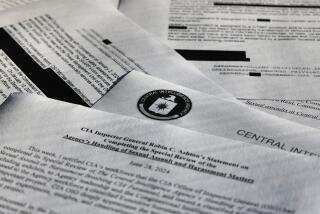CIA reports detail harsh interrogations when chief Gina Haspel led Thailand black site
Reporting from Washington â Newly unclassified CIA documents provide fresh details on the brutal treatment of a terrorism suspect in late 2002 at a secret prison in rural Thailand then run by Gina Haspel, who was confirmed in May as CIA director after a contentious Senate hearing.
The 16 redacted cables between CIA headquarters in Virginia and the so-called black site prison in Thailand, which the National Security Archive at George Washington University obtained through a Freedom of Information Act lawsuit, describe extended sessions of physical violence, forced nudity, sleep deprivation, box confinement and waterboarding of an Al Qaeda suspect.
The cables donât dramatically change the understanding of what the CIA called enhanced interrogation techniques and critics called torture at a now-shuttered network of secret detention sites overseas. But they do provide more graphic details of what happened when Haspel was in charge of an interrogation site the CIA had code named âGreen.â
One cable, dated Dec. 1, 2002, is especially vivid. It says an interrogator âstrode, catlike, into the well-lit confines of the cell at 0902 hrs [redacted], deftly removed the subjectâs black hood with a swipe, paused, and in a deep, measured voice said that subject â having âcalmed downâ after his (staged) run-in with his hulking, heavily muscled guards the previous day â should reveal what subject had done to vex his guards to the point of rage.â
The CIA had refused to release the material during Haspelâs Senate confirmation hearing, but the Archive posted them online Friday.
The cables all focus on the interrogation of Abd al Rahim al Nashiri, a Saudi citizen suspected of helping to orchestrate the 2000 bombing of the U.S. destroyer Cole in a Yemeni port, killing 17 U.S. sailors. Now imprisoned at Guantanamo Bay, he was captured in Dubai in October 2002 and taken to the Thailand prison in mid-November, where he was interrogated for three weeks.
According to one cable, the âaggressive interrogation phaseâ began at 4:15 a.m. one day. âSubject was warned not to lie, and was told that if he lied, he would suffer the consequences, and his life would become infinitely worse,â the cable said.
The Sept. 11 attacks were barely a year old, and interrogators demanded information about future terrorist strikes. When Nashiri did not immediately respond, âsubjectâs clothes were ripped off of him by security team members while the interrogator told subject we knew he was lying,â the cable said.
As interrogators demanded answers, âsubject whimpered that he would do anything the interrogators wanted.â
The episode ended when one of the interrogators pointed at a âlarge boxâ in the room and told Nashiri, âIt was now his new home.â He was then hooded and locked in the coffin-sized box for about 12 hours.
The harsh treatment continued for days, sometimes lasting for hours. Interrogators repeatedly âwalledâ Nashiri, meaning they slammed him into a wall, or locked him inside an even smaller box than before.
After several days, âsubject was told that he was going to suffer,â and interrogators began to waterboard him, a painful and terrifying technique that involves forcing water down a prisonerâs throat to simulate drowning. In all, he was waterboarded three times.
When strapped to the table, Nashiri began to cry and he âpromised to tell everything he knew, but added that he knew nothing.â Interrogators continued âthe water treatment,â the cable said, and left Nashiri on the table, âmoaning, shaking and asking God to help him repeatedly.â
Thereâs no indication that Nashiri provided useful intelligence about future plots. An extensive report from Democrats on the Senate Intelligence Committee released in 2014 said the brutal interrogations did not help prevent imminent terrorist attacks, and they sometimes led to false confessions as suspects desperately sought to stop the abuse.
Haspelâs name does not appear in the redacted cables. But Tom Blanton, the director of the National Security Archive, said Haspel would have written them or authorized their transmission while serving as chief of base.
The CIA has never publicly confirmed that Haspel supervised the Thailand black site while Nashiri was interrogated there, nor has it officially confirmed the existence of the secret prison. It was closed in December 2002 after tensions with the Thai government and fears a newspaper would report its location, but the CIA transferred Nashiri to a similar site in Poland and used other secret prisons around the world, according to the Senate report.
The CIA declined to comment on the cables.
Torture was a key issue during Haspelâs confirmation process in May, and she was narrowly confirmed, by a vote of 54 to 45, after a handful of Democrats supported her. Haspel told her confirmation hearing that she would not restart the interrogation and detention program.
âHaving served in that tumultuous time, I can offer you my personal commitment, clearly and without reservation, that under my leadership, CIA will not restart such a detention and interrogation program,â she said.
Her answers did not satisfy some congressional critics, especially after she pledged to follow her âmoral compassâ as CIA director, but wouldnât say whether previous practices were immoral.
âIâm not going to sit here, with the benefit of hindsight, and judge the very good people who made hard decisions in extraordinary circumstances,â Haspel said.
Follow the latest news of the Trump administration on Essential Washington »
Twitter: @chrismegerian
More to Read
Get the L.A. Times Politics newsletter
Deeply reported insights into legislation, politics and policy from Sacramento, Washington and beyond. In your inbox three times per week.
You may occasionally receive promotional content from the Los Angeles Times.











